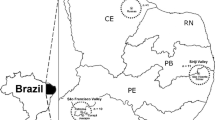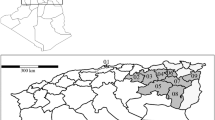Abstract
During extensive surveys for Phytophthora associated with alder mortality in western Spain, isolates were consistently recovered from necrotic bark of the collar and lower stem of Alnus glutinosa. Morphological and molecular characteristics of the selected isolates together with their physiology were examined. Morphologically, the isolates were homothallic and characterized by abundant production of terminal oogonia predominantly with two-celled amphigynous antheridia exhibiting ornamentation. Simple sporangiophores were observed bearing terminal, non-papillate, ellipsoid to ovoid sporangia. Colony growth patterns developed on V8 juice agar (V8A), carrot agar (CA), corn-meal agar (CMA) and potato-dextrose agar (PDA) showed uniform, radial or irregular growth patterns with appressed and/or woolly morphology. Temperature (2 °C, 5 °C, 10 °C, 15 °C, 20 °C, 25 °C, 27 °C, 30 °C and 32 °C), pH (5, 7, 9 and 11) and osmotic potential (−0.6, −1.2, −1.8 and −2.4 MPa) significantly influenced radial mycelial growth of the isolates under laboratory conditions. Molecular analyses including ITS DNA region sequencing and subspecies specific primers amplification confirmed identification of the isolates as Phytophthora alni ssp. alni. Further research is under way to carry out more surveys in order to determine the extent of damage and severity of the disease in different regions of Spain.







Similar content being viewed by others
References
Aguayo, J., Adams, G. C., Halkett, F., Catal, M., Husson, C., Nagy, Z. Á., Hansen, E. M., Marçais, B., & Frey, P. (2013). Strong genetic differentiation between North American and European populations of Phytophthora alni subsp. uniformis. Phytopathology, 103(2), 190–199.
Andrivon, D. (1994). Fate of Phytophthora infestans in a suppressive soil in relation to pH. Soil Biology and Biochemistry, 26, 953–956.
Ayres, P. G., & Boddy, L. (1986). Water, fungi and plants. Cambridge: Cambridge University Press.
Blaker, N. S., & MacDonald, J. D. (1983). Influence of container medium pH on sporangium formation, zoospore release, and infection of rhododendron by Phytophthora cinnamomi. Plant Disease, 67, 259–263.
Brasier, C. M., & Kirk, S. A. (2001). Comparative aggressiveness of standard and variant hybrid alder Phytophthora, Phytophthora cambivora and other Phytophthora species on the bark of Alnus, Quercus and other woody hosts. Plant Pathology, 50, 218–229.
Brasier, C. M., Rosen, J., & Gibbs, J. N. (1995). An unusual Phytophthora associated with widespread alder mortality in Britain. Plant Pathology, 44, 999–1007.
Brasier, C. M., Cooke, D. E. L., & Duncan, J. M. (1999). Origin of a new Phytophthora pathogen through interspecific hybridization. Proceedings of the National Academy of Sciences, 96, 5878–5883. USA.
Brasier, C. M., Kirk, S. A., Delcan, J., Cooke, D., Jung, T., & Man In’T Veld, W. A. (2004). Phytophthora alni sp. nov. and its variants: designation of emerging heteroploid hybrid pathogens spreading on Alnus trees. Mycological Research, 108, 1172–1184.
Cerný, K., & Strnadová, V. (2010). Phytophthora alder decline: disease symptoms, causal agent and its distribution in the Czech Republic. Plant Protection Science, 46(1), 12–18.
Cerny, K., Gregorova, B., Strnadova, V., Holub, V., Tomsovsky, M., & Cervenka, M. (2008). Phytophthora alni causing decline of black and grey alders in the Czech Republic. Plant Pathology, 57, 370.
Davis, D. J., Burlak, C., & Money, N. P. (2000). Osmotic pressure of fungal compatible osmolytes. Mycological Research, 104(7), 800–804.
Gardes, M., & Bruns, T. D. (1993). ITS primers with enhanced specificity for basidiomycetes: application to the identification of mycorrhiza and rusts. Molecular Ecology, 2(2), 113–118.
Gibbs, J. N., Strouts, R., Rose, J., & Brasier, C. (1994). An unusual Phytophthora associated with disease of common alder. Report on Forest Research (pp. 27–28). London: HMSO.
Gibbs, J. N., Lipscombe, M. A., & Peace, A. J. (1999). The impact of Phytophthora disease on riparian populations of common alder (Alnus glutinosa) in southern Britain. European Journal of Forest Pathology, 29, 39–50.
Gibbs, J. N., Van Dijk, C., & Webber, J. F. (2003). Phytophthora Disease of Alder in Europe. Forestry Commission Bulletin No. 126. p. 82 Edinburgh, UK .
Hong, C. X., & Moorman, G. W. (2005). Plant pathogens in irrigation water: challenges and opportunities. Critical Reviews in Plant Sciences, 24, 189–208.
Ioos, R., Husson, C., Andrieux, A., & Frey, P. (2005). SCAR based PCR primers to detect the hybrid pathogen Phytophthora alni and its subspecies causing alder disease in Europe. European Journal of Plan Pathology, 112, 323–335.
Ioos, R., Andrieux, A., Marçais, B., & Frey, P. (2006). Genetic characterization of the natural hybrid species Phytophthora alni as inferred from nuclear and mitochondrial DNA analyses. Fungal Genetics and Biology, 43, 511–529.
Ioos, R., Barrès, B., Andrieux, A., & Frey, P. (2007). Characterization of microsatellite markers in the interspecific hybrid Phytophthora alni ssp. alni, and cross-amplification with related taxa. Molecular Ecolology Notes, 7, 133–137.
Ioos, R., Fabre, B., Saurat, C., Fourrier, C., Frey, P., & Marçais, B. (2010). Development, comparison, and validation of real-time and conventional PCR tools for the detection of the fungal pathogens causing brown spot and red band needle blights of pine. Phytopathology, 100, 105–114.
Jung, T., & Blaschke, M. (2004). Phytophthora root and collar rot of alders in Bavaria: Distribution, modes of spread and possible management strategies. Plant Pathology, 53, 197–208.
Jung, T., Cooke, D. E. L., Blaschke, H., Duncan, J. M., & Osswald, W. (1999). Phytophthora quercina sp. nov. causing root rot of European oaks. Mycological Research, 103, 785–798.
Kaosiri, T., Zentmyer, G. A., & Erwin, D. C. (1978). Stalk length as a taxonomic criterion for Phytophthora palmivora isolates from cacao. Canadian Journal of Botany, 56, 1730–1738.
Kong, P., Moorman, G. W., Lea-cox, J. D., Ross, D. S., Richardson, P. A., & Hong, C. (2009). Zoosporic tolerance to pH stress and its implications for Phytophthora species in aquatic ecosystems. Applied and Environmental Microbiology, 75(13), 4307–4314.
Kong, P., Lea-cox, J. D., Moorman, G. W., & Hong, C. (2012). Survival of Phytophthora alni, Phytophthora kernoviae, and Phytophthora ramorum in a simulated aquatic environment at different levels of pH. FEMS Microbiology Letters, 332(1), 54–60.
Lira-Méndez, K., & Mayek-Pérez, N. (2006). Potencial osmótico variable en el crecimiento in vitro y la patogenicidad en frijol (Phaseolus vulgaris L.) de Fusarium spp. Revista Mexicana de Fitopatologia, 24(2), 88–97.
Moon, C. D., Craven, K. D., Leuchtmann, A., Clement, S. L., & Schardl, C. L. (2004). Prevalence of inter-specific hybrids amongst asexual fungal endophytes of grasses. Molecular Ecology, 13, 1455–1467.
R Core Team. (2014). R: A language and environment for statistical computing: R Foundation for Statistical Computing. Vienna, Austria. http://www.R-project.org/
Solla, A., Pérez-Sierra, A., Corcobado, T., Haque, M. M., Diez, J. J., & Jung, T. (2010). Phytophthora alni on Alnus glutinosa reported for the first time in Spain. Plant Pathology, 59, 798.
Sommers, L. E., Harris, R. F., Dalton, F. N., & Gardner, W. R. (1970). Water potential relations of three root-infecting Phytophthora species. Phytopathology, 60, 932–934.
Szabó, I., Nagy, Z., Bakonyi, J., & Érsek, T. (2000). First report of Phytophthora root and collar rot of alder in Hungary. Plant Disease, 84, 1251.
Thomas, F. M., Blank, R., & Hatmann, G. (2002). Abiotic and biotic factors and their interactions as causes of oak decline in Central Europe. Forest Pathology, 32, 277–307.
Turco, E., Barzanti, G. P., Capretti, P., & Ragazzi, A. (2005). Effect of polyethylene glycol and composition of basal medium on the mycelial growth of Phytophthora spp. Journal of Plant Diseases and Protection, 112(5), 426–436.
Tuset, J. J., González, V., Hinarejos, C., Mira, J. L., & Sánchez, G. (2006). Prospección para determinar la posible presencia de Phytophthora spp. en las alisedas del norte de España. In J. M. Cobos (Ed.), Proceedings of the XXIII Annual Meeting of the Forest Health Working Group (pp. 527–537). Madrid, Spain.
Vainio, E. J., Korhonen, K., & Hantula, J. (1998). Genetic variation in Phlebiopsis gigantea as detected with random amplified microsatellite (RAMS) markers. Mycological Research, 102, 187–192.
Varela, C. P., Martinez, C. R., Vázquez, J. P. M., & Casal, O. A. (2010). First Report of Phytophthora rot on Alders Caused by Phytophthora alni subsp. alni in Spain. Plant Disease, 94(2), 273.
Varela, C. P., Martínez, C. R., Casal, O. A., Vázquez, J. P. M., & Yebra, A. A. (2012). First Report of Phytophthora alni subsp. uniformis on Black Alder in Spain. Plant Disease, 96(4), 589.
Vilgalys, R., & Hester, M. (1990). Rapid genetic identification and mapping of enzymatically amplified ribosomal DNA from several Cryptococcus species. Journal of Bacteriology, 172, 4238–4246.
Waterhouse, G. M. (1963). Key to the species of Phytophthora de Bary. Mycological Papers, 92, 1–22.
Weste, G. (1983). Population dynamics and survival of Phytophthora, p. 237–258. In D. C. Erwin, S. Bartnicki-Garcia, & P. H. Tsao (Eds.), Phytophthora: its biology, taxonomy, ecology and pathology. Saint Paul: APS Press.
White, T. J., Bruns, T., Lee, S., & Taylor, J. W. (1990). Amplification and direct sequencing of fungal ribosomal RNA genes for phylogenetics. In M. A. Innis, D. H. Gelfand, J. J. Sninsky, & T. J. White (Eds.), PCR protocols: a guide to methods and applications (pp. 315–322). New York: Academic.
Acknowledgments
The authors are grateful to Juan Carlos (Centro de Sanidad Forestal de Calabazanos, Junta de Castilla y León, Spain) for his technical assistance during fieldwork. The authors are also like to thank Claude Husson for supplying us the French isolates of P. alni.
Author information
Authors and Affiliations
Corresponding author
Rights and permissions
About this article
Cite this article
Haque, M.M.U., Hidalgo, E., Martín-García, J. et al. Morphological, physiological and molecular characterization of Phytophthora alni isolates from Western Spain. Eur J Plant Pathol 142, 731–745 (2015). https://doi.org/10.1007/s10658-015-0647-2
Accepted:
Published:
Issue Date:
DOI: https://doi.org/10.1007/s10658-015-0647-2




